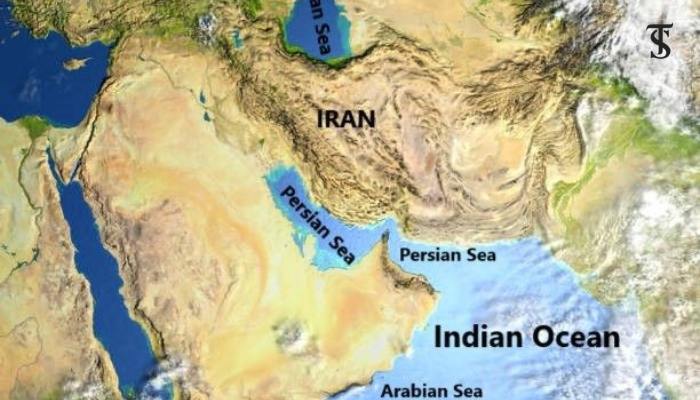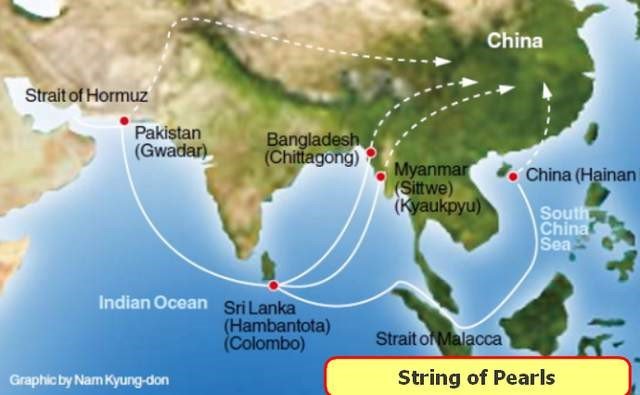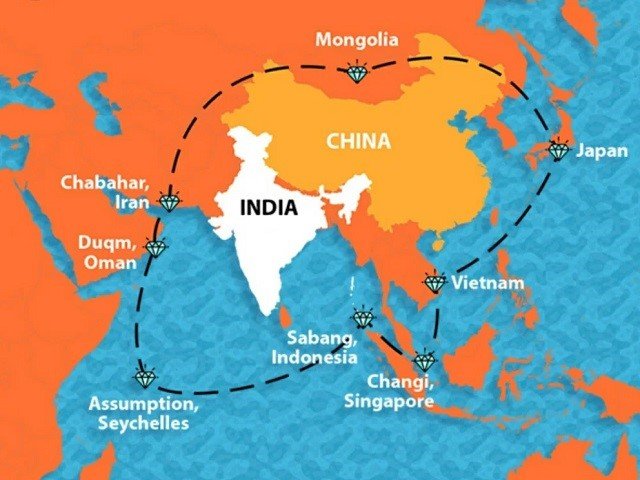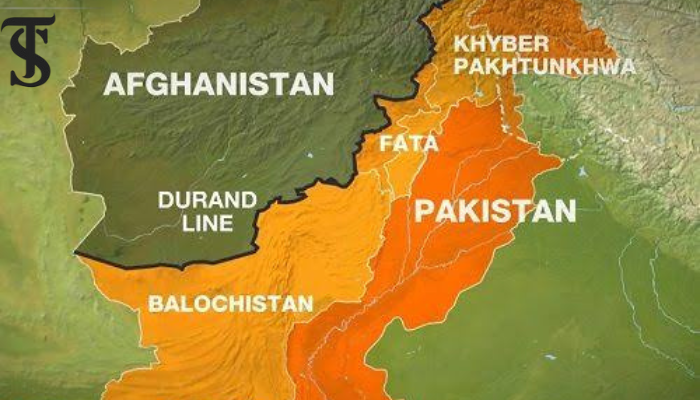The Indian Ocean: A Battleground for Global Influence

- China’s Expansion: The “String of Pearls” strategy strengthens China’s influence in the Indian Ocean through strategic ports like Gwadar, Hambantota, and Kyaukpyu.
- India’s Countermove: The “Necklace of Diamonds” strategy enhances India’s naval presence, securing key ports like Changi, Sabang, and Duqm to counter China.
- Global Impact: The intensifying India-China rivalry in the IOR affects global trade, security, and strategic alliances, shaping the region’s geopolitical landscape.
Whoever controls the Indian Ocean will dominate Asia. This ocean is the key to the seven seas. In the 21st century, the destiny of the world will be decided on its waters.” Alfred Thayer Mahan. The Indian Ocean Region (IOR) has become a crucial arena in the ongoing strategic rivalry due to its significant geopolitical and economic importance. Through its “String of Pearls” strategy, China is developing a network of strategic ports and infrastructure to secure key trade routes, expand its naval presence, and enhance its influence across the region. In response, India has adopted its “Necklace of Diamonds” strategy, which focuses on countering China’s influence, protecting vital trade routes, and asserting itself as a net security provider in the region through increased naval cooperation and partnerships. This intensifying rivalry underscores the IOR’s growing importance in shaping the global balance of power.
The Indian Ocean Region (IOR) covers about 20% of the world’s oceans and is important for linking Africa, Asia, and Australia. Even though it is the smallest of the three major oceans, the IOR is the most complicated because of its strategic location and its role in global trade.

Bordered by 38 countries and stretching over 6,200 miles, the IOR handles approximately 80% of the world’s trade, making it very important for both economic and political reasons. Key Sea Lines of Communication (SLOCs), like the Strait of Hormuz, Strait of Malacca, Bab-el-Mandeb, and Mozambique Channel, are essential for global trade, and any problems in these areas could greatly harm economies in the IOR.
China’s Growing Influence in the Indian Ocean:
Since 2008, the Chinese navy has been growing its presence in the Indian Ocean. This began with the deployment of both nuclear and conventional submarines, followed by missions to fight piracy. By 2015, China had become much more involved in the Indian Ocean, making big investments, gaining political power, and establishing a military presence along the maritime Silk Road. This helped China become an important player in the region.
A key move was opening its first military base in Djibouti, a small country in East Africa on a main route between Europe and the rest of the world. This military base has raised worries worldwide about China’s growing influence.
China’s “String of Pearls” strategy aims to create a network of important ports and infrastructure in the Indian Ocean Region (IOR) to increase its power and secure key shipping routes for trade and military use. This plan includes building or upgrading ports in key locations like Pakistan, Sri Lanka, Bangladesh, and Myanmar. These ports serve as economic centres and military bases, helping China access important sea routes more easily.
Gwadar Port, part of the China-Pakistan Economic Corridor (CPEC), provides China with direct access to the Arabian Sea, bypassing the Malacca Strait, and positions it near the Strait of Hormuz, a vital oil transport route. In Sri Lanka, China has secured a 99-year lease on Hambantota Port after Sri Lanka struggled with debt repayments. This port, located near major Indian Ocean shipping routes, allows China to monitor Indian activities closely. Chittagong Port in Bangladesh plays a critical role in China’s Belt and Road Initiative (BRI) and the BCIM corridor, increasing China’s naval and economic influence in the Bay of Bengal. Similarly, Kyaukpyu Port in Myanmar, part of a $7.3 billion project linking Myanmar to China’s Yunnan province, strengthens China’s maritime presence and ensures energy security.
Through these ports and its growing naval presence, China has successfully secured key sea routes, expanded its strategic influence in the Indian Ocean, and reinforced its position as a major regional power.
India’s countermeasures and strategic initiatives:
India, on the eastern side of the Indian Ocean, holds a central position, making it a significant continental power in the region.
KM Panikkar, a key figure in India’s maritime strategy, said that “to other countries the Indian Ocean could be only one of the important oceanic areas, but to India it is a vital sea because its lifelines are concentrated in that area; its freedom is dependent on the freedom of that coastal surface.”
India’s naval strategy, initially outlined in 2004, was designed to ensure safe passage at sea and protect crucial trade and communication routes. In 2015, this strategy was updated to focus more on enhancing security in India’s maritime areas. As part of this strategy, India aims to be a “net security provider,” helping to strengthen regional security by addressing shared challenges like piracy and coordinating disaster relief efforts.
On August 29, 2024, the Indian Navy launched its second Arihant-class submarine. Its coastal search and rescue network (SAR) now reaches island nations in the Indian Ocean Region, using radar systems for improved coverage. India plans to invest significantly in this region while strengthening its political, economic, and military ties.
The “Necklace of Diamonds” is a strategic concept introduced by India’s former Foreign Secretary in 2011 to counter China’s growing influence in the Indian Ocean. This strategy targets China’s expanding presence through ports and infrastructure projects in neighbouring countries, which India views as a potential threat aimed at encircling it. As part of this strategy, India has secured access to key ports, including the Changi Naval Base in Singapore, which provides the Indian Navy with refuelling and rearming capabilities while operating in the South China Sea.

In 2018, India also gained access to Sabang Port in Indonesia, located at the entrance to the vital Malacca Strait, a crucial maritime chokepoint. Furthermore, India secured access to Duqm Port in Oman, strategically positioned between China’s key ports in the region, thus strengthening its presence in the Arabian Sea and countering China’s growing footprint.These strategic access points are central to India’s efforts to safeguard its interests in the Indian Ocean and to counterbalance China’s growing presence in the region.
Moreover, India is actively participating in naval exercises in the Indian Ocean and working with countries that have similar maritime goals, especially considering China’s assertiveness and ensuring freedom of navigation.
Some examples of these collaborations include: The India-Japan-U.S. Dialogue, the Australia-India-Indonesia Trilateral Dialogue, and the Quadrilateral Security Dialogue (QUAD), which involves Australia, India, Japan, and the U.S. Other naval exercises with similar objectives are the Malabar exercises, which involve India, Australia, Japan, and the U.S.; the India-Brazil-South Africa Maritime (IBSAMAR) exercises; and the biennial Milan exercises.
In Conclusion, the India-China maritime rivalry reflects their broader geopolitical ambitions and underscores the Indian Ocean’s growing importance in global security and trade. . As competition intensifies, the region’s significance in shaping the global power balance will continue to grow.
Eman Hassan
The author is a student of International Relations at the University of Sargodha.





